| Western blot (WB): | 1:500-2000 |
| Immunohistochemistry (IHC): | 1:50-400 |
| Immunocytochemistry/Immunofluorescence (ICC/IF): | 1:50-400 |
| Flow Cytometry (Fixed): | 1:50-200 |
| Enzyme linked immunosorbent assay (ELISA): | 1:100-1000 |
| (Boiling the paraffin sections in 10mM citrate buffer,pH6.0,or PH8.0 EDTA repair liquid for 20 mins is required for the staining of formalin/paraffin sections.) Optimal working dilutions must be determined by end user. | |
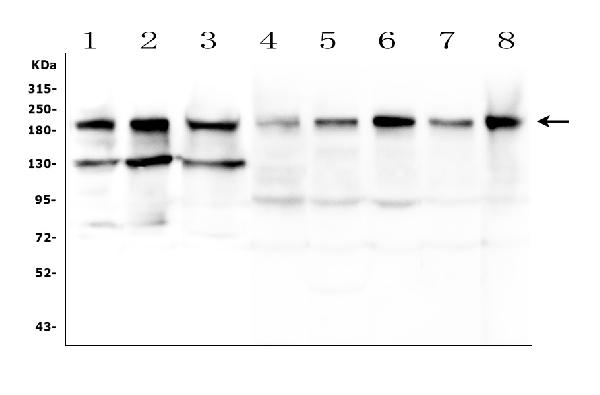
Western blot analysis of BCL9L using anti-BCL9L antibody (A05905). The sample well of each lane was loaded with 50ug of sample under reducing conditions. Lane 1: human Hela whole cell lysates, Lane 2: human T-47D whole cell lysates, Lane 3: human PANC-1 whole cell lysates, Lane 4: rat testicular issue lysates, Lane 5: rat liver issue lysates, Lane 6: mouse testicular issue lysates, Lane 7: mouse thymus issue lysates, Lane 8: mouse HEPA1-6 whole cell lysates. anti-BCL9L antigen affinity purified polyclonal antibody (Catalog # A05905)probed with a goat anti-rabbit IgG-HRP secondary antibody The signal is developed using an Enhanced Chemiluminescent detection (ECL) kit (Catalog # EK1002) . A specific band was detected for BCL9L at approximately 200KD. The expected band size for BCL9L is at 157KD.

Western blot analysis of BCL9L using anti-BCL9L antibody (A05905). The sample well of each lane was loaded with 30 ug of sample under reducing conditions.
Lane 1: human Hela whole cell lysates,
Lane 2: human T-47D whole cell lysates,
Lane 3: human PANC-1 whole cell lysates,
Lane 4: rat testicular issue lysates,
Lane 5: rat liver issue lysates,
Lane 6: mouse testicular issue lysates,
Lane 7: mouse thymus issue lysates,
Lane 8: mouse HEPA1-6 whole cell lysates.
After electrophoresis, proteins were transferred to a membrane. Then the membrane was incubated with rabbit anti-BCL9L antigen affinity purified polyclonal antibody (A05905) at a dilution of 1:1000 and probed with a goat anti-rabbit IgG-HRP secondary antibody (Catalog # BA1054). The signal is developed using ECL Plus Western Blotting Substrate (Catalog # AR1197). A specific band was detected for BCL9L at approximately 200 kDa. The expected band size for BCL9L is at 157 kDa.

IHC analysis of BCL9L using anti-BCL9L antibody (A05905).
BCL9L was detected in a paraffin-embedded section of human lung cancer tissue. Biotinylated goat anti-rabbit IgG was used as secondary antibody. The tissue section was incubated with rabbit anti-BCL9L Antibody (A05905) at a dilution of 1:200 and developed using Strepavidin-Biotin-Complex (SABC) (Catalog # SA1022) with DAB (Catalog # AR1027) as the chromogen.
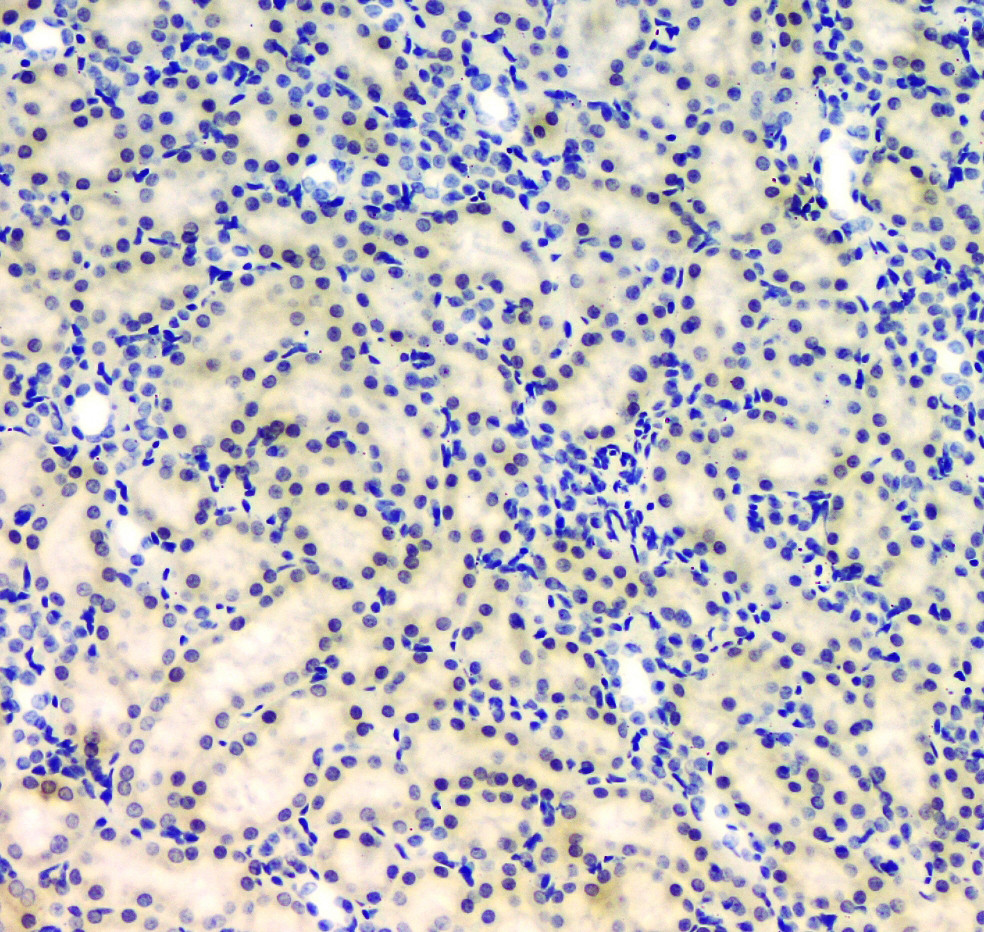
IHC analysis of BCL9L using anti-BCL9L antibody (A05905).
BCL9L was detected in a paraffin-embedded section of human Ovarian cancer tissue. Biotinylated goat anti-rabbit IgG was used as secondary antibody. The tissue section was incubated with rabbit anti-BCL9L Antibody (A05905) at a dilution of 1:200 and developed using Strepavidin-Biotin-Complex (SABC) (Catalog # SA1022) with DAB (Catalog # AR1027) as the chromogen.

IHC analysis of BCL9L using anti-BCL9L antibody (A05905).
BCL9L was detected in a paraffin-embedded section of rat kidney tissue. Biotinylated goat anti-rabbit IgG was used as secondary antibody. The tissue section was incubated with rabbit anti-BCL9L Antibody (A05905) at a dilution of 1:200 and developed using Strepavidin-Biotin-Complex (SABC) (Catalog # SA1022) with DAB (Catalog # AR1027) as the chromogen.
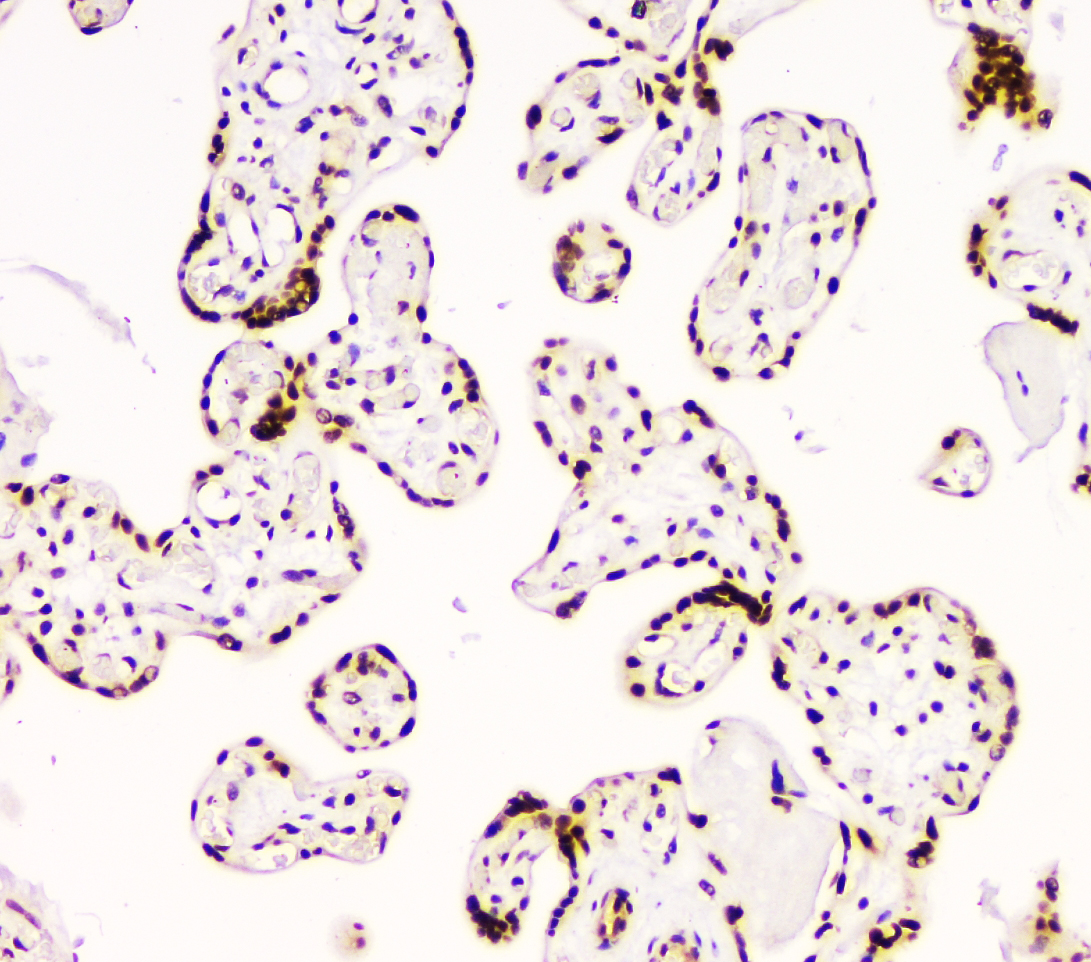
IHC analysis of BCL9L using anti-BCL9L antibody (A05905).
BCL9L was detected in a paraffin-embedded section of human oesophagus squama cancer tissue. Biotinylated goat anti-rabbit IgG was used as secondary antibody. The tissue section was incubated with rabbit anti-BCL9L Antibody (A05905) at a dilution of 1:200 and developed using Strepavidin-Biotin-Complex (SABC) (Catalog # SA1022) with DAB (Catalog # AR1027) as the chromogen.
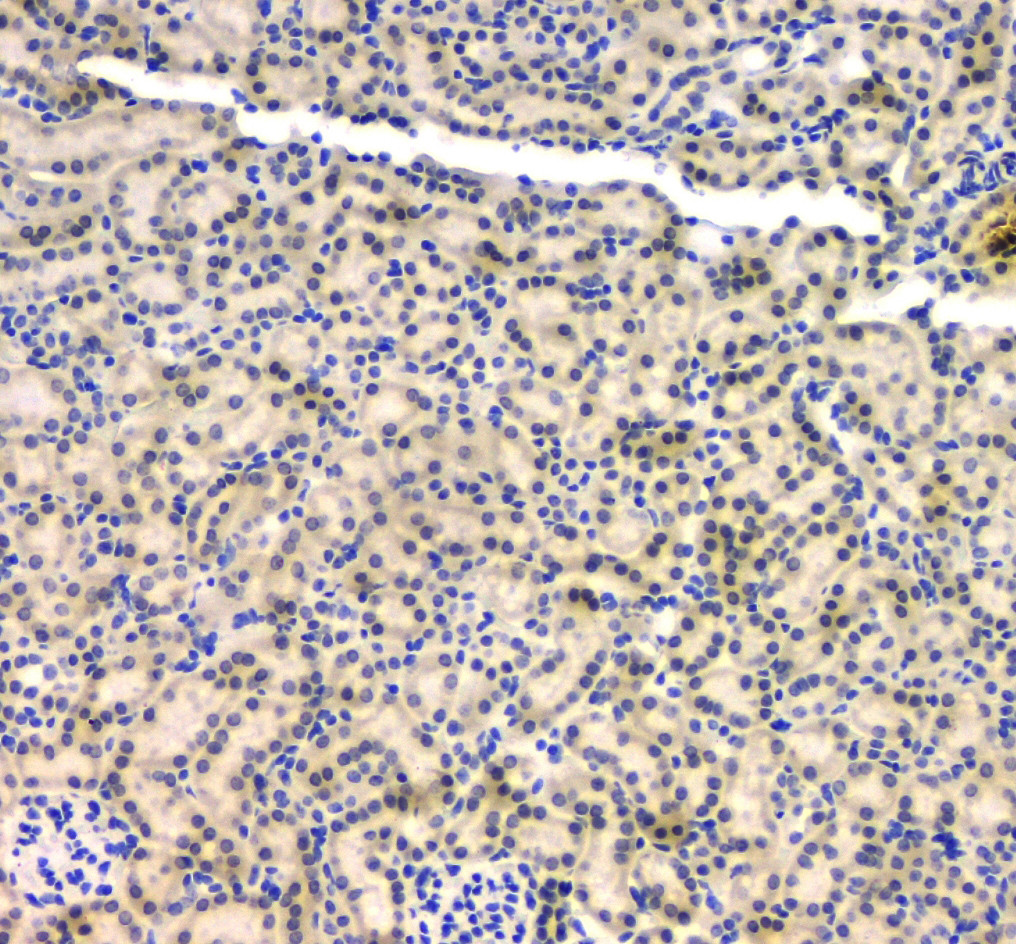
IHC analysis of BCL9L using anti-BCL9L antibody (A05905).
BCL9L was detected in a paraffin-embedded section of human placenta tissue. Biotinylated goat anti-rabbit IgG was used as secondary antibody. The tissue section was incubated with rabbit anti-BCL9L Antibody (A05905) at a dilution of 1:200 and developed using Strepavidin-Biotin-Complex (SABC) (Catalog # SA1022) with DAB (Catalog # AR1027) as the chromogen.
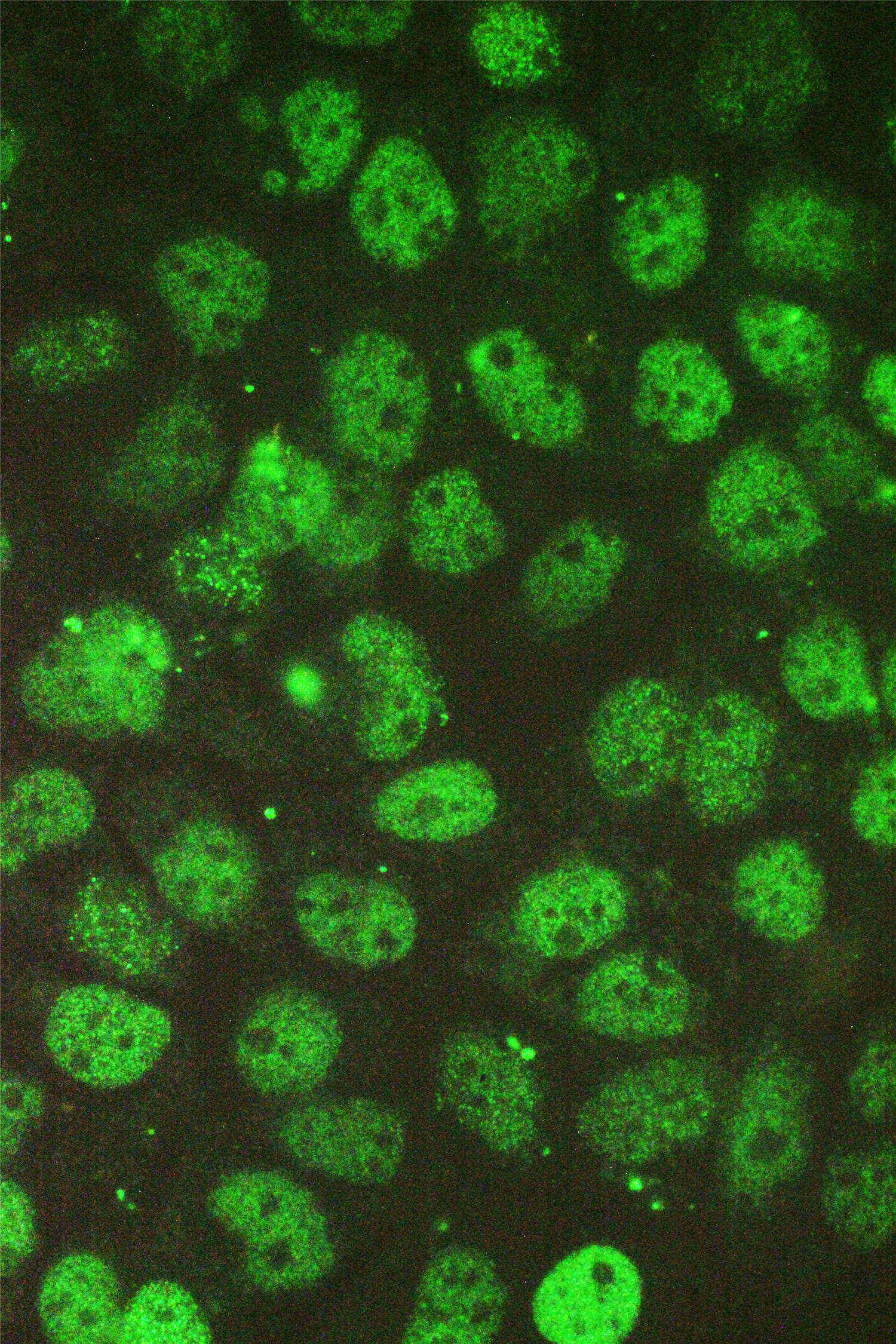
IHC analysis of BCL9L using anti-BCL9L antibody (A05905).
BCL9L was detected in a paraffin-embedded section of mouse kidney tissue. Biotinylated goat anti-rabbit IgG was used as secondary antibody. The tissue section was incubated with rabbit anti-BCL9L Antibody (A05905) at a dilution of 1:200 and developed using Strepavidin-Biotin-Complex (SABC) (Catalog # SA1022) with DAB (Catalog # AR1027) as the chromogen.

IF analysis of BCL9L using anti- BCL9L antibody (A05905).
BCL9L was detected in immunocytochemical section of A431 cell. Enzyme antigen retrieval was performed using IHC enzyme antigen retrieval reagent (AR0022) DyLight488 Conjugated Goat Anti-Rabbit IgG (BA1127) was used as secondary antibody Visualize using a fluorescence microscope and filter sets appropriate for the label used.
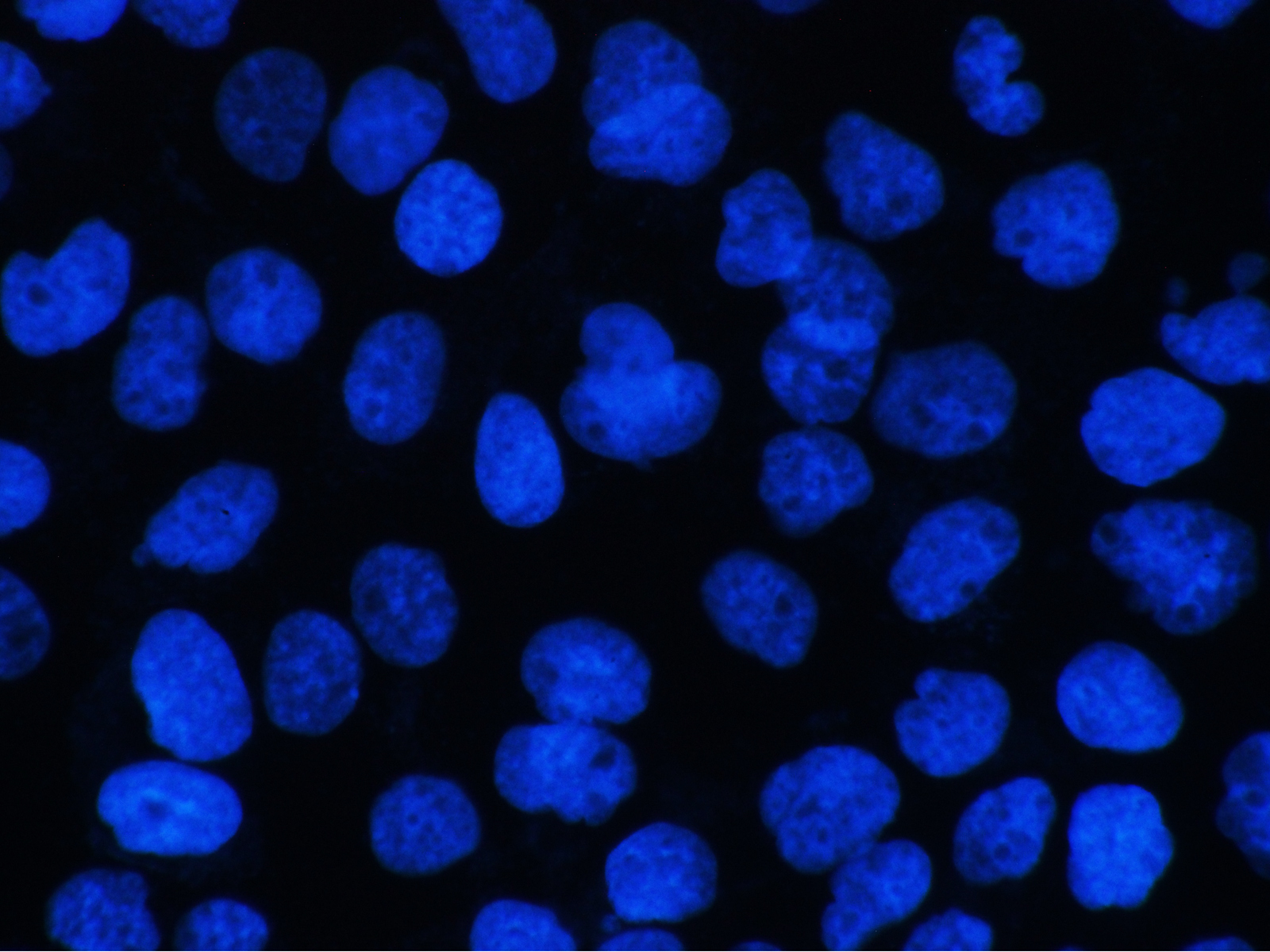
IF analysis of BCL9L using anti- BCL9L antibody (A05905).
BCL9L was detected in immunocytochemical section of A431 cell. Enzyme antigen retrieval was performed using IHC enzyme antigen retrieval reagent (AR0022) rabbit anti- BCL9L Antibody (A05905) . DyLight488 Conjugated Goat Anti-Rabbit IgG (BA1127) was used as secondary antibody Visualize using a fluorescence microscope and filter sets appropriate for the label used.
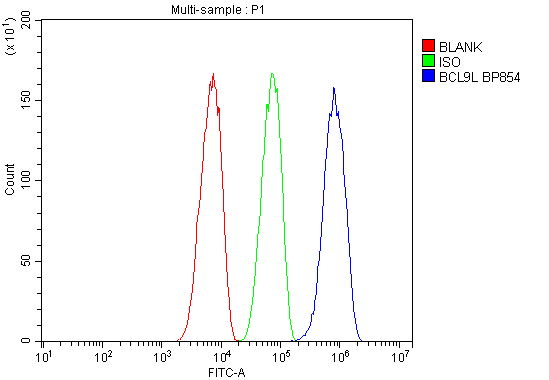
IF analysis of BCL9L using anti- BCL9L antibody (A05905).
BCL9L was detected in immunocytochemical section of A431 cell. Enzyme antigen retrieval was performed using IHC enzyme antigen retrieval reagent (AR0022) rabbit anti- BCL9L Antibody (A05905) . DyLight488 Conjugated Goat Anti-Rabbit IgG (BA1127) was used as secondary antibody The section was counterstained with DAPI. Visualize using a fluorescence microscope and filter sets appropriate for the label used.

Western blot analysis of BCL9L using anti-BCL9L antibody (A05905). The sample well of each lane was loaded with 50ug of sample under reducing conditions. Lane 1: human Hela whole cell lysates, Lane 2: human T-47D whole cell lysates, Lane 3: human PANC-1 whole cell lysates, Lane 4: rat testicular issue lysates, Lane 5: rat liver issue lysates, Lane 6: mouse testicular issue lysates, Lane 7: mouse thymus issue lysates, Lane 8: mouse HEPA1-6 whole cell lysates. anti-BCL9L antigen affinity purified polyclonal antibody (Catalog # A05905)probed with a goat anti-rabbit IgG-HRP secondary antibody The signal is developed using an Enhanced Chemiluminescent detection (ECL) kit (Catalog # EK1002) . A specific band was detected for BCL9L at approximately 200KD. The expected band size for BCL9L is at 157KD.

Western blot analysis of BCL9L using anti-BCL9L antibody (A05905). The sample well of each lane was loaded with 30 ug of sample under reducing conditions.
Lane 1: human Hela whole cell lysates,
Lane 2: human T-47D whole cell lysates,
Lane 3: human PANC-1 whole cell lysates,
Lane 4: rat testicular issue lysates,
Lane 5: rat liver issue lysates,
Lane 6: mouse testicular issue lysates,
Lane 7: mouse thymus issue lysates,
Lane 8: mouse HEPA1-6 whole cell lysates.
After electrophoresis, proteins were transferred to a membrane. Then the membrane was incubated with rabbit anti-BCL9L antigen affinity purified polyclonal antibody (A05905) at a dilution of 1:1000 and probed with a goat anti-rabbit IgG-HRP secondary antibody (Catalog # BA1054). The signal is developed using ECL Plus Western Blotting Substrate (Catalog # AR1197). A specific band was detected for BCL9L at approximately 200 kDa. The expected band size for BCL9L is at 157 kDa.

IHC analysis of BCL9L using anti-BCL9L antibody (A05905).
BCL9L was detected in a paraffin-embedded section of human lung cancer tissue. Biotinylated goat anti-rabbit IgG was used as secondary antibody. The tissue section was incubated with rabbit anti-BCL9L Antibody (A05905) at a dilution of 1:200 and developed using Strepavidin-Biotin-Complex (SABC) (Catalog # SA1022) with DAB (Catalog # AR1027) as the chromogen.

IHC analysis of BCL9L using anti-BCL9L antibody (A05905).
BCL9L was detected in a paraffin-embedded section of human Ovarian cancer tissue. Biotinylated goat anti-rabbit IgG was used as secondary antibody. The tissue section was incubated with rabbit anti-BCL9L Antibody (A05905) at a dilution of 1:200 and developed using Strepavidin-Biotin-Complex (SABC) (Catalog # SA1022) with DAB (Catalog # AR1027) as the chromogen.

IHC analysis of BCL9L using anti-BCL9L antibody (A05905).
BCL9L was detected in a paraffin-embedded section of rat kidney tissue. Biotinylated goat anti-rabbit IgG was used as secondary antibody. The tissue section was incubated with rabbit anti-BCL9L Antibody (A05905) at a dilution of 1:200 and developed using Strepavidin-Biotin-Complex (SABC) (Catalog # SA1022) with DAB (Catalog # AR1027) as the chromogen.

IHC analysis of BCL9L using anti-BCL9L antibody (A05905).
BCL9L was detected in a paraffin-embedded section of human oesophagus squama cancer tissue. Biotinylated goat anti-rabbit IgG was used as secondary antibody. The tissue section was incubated with rabbit anti-BCL9L Antibody (A05905) at a dilution of 1:200 and developed using Strepavidin-Biotin-Complex (SABC) (Catalog # SA1022) with DAB (Catalog # AR1027) as the chromogen.

IHC analysis of BCL9L using anti-BCL9L antibody (A05905).
BCL9L was detected in a paraffin-embedded section of human placenta tissue. Biotinylated goat anti-rabbit IgG was used as secondary antibody. The tissue section was incubated with rabbit anti-BCL9L Antibody (A05905) at a dilution of 1:200 and developed using Strepavidin-Biotin-Complex (SABC) (Catalog # SA1022) with DAB (Catalog # AR1027) as the chromogen.

IHC analysis of BCL9L using anti-BCL9L antibody (A05905).
BCL9L was detected in a paraffin-embedded section of mouse kidney tissue. Biotinylated goat anti-rabbit IgG was used as secondary antibody. The tissue section was incubated with rabbit anti-BCL9L Antibody (A05905) at a dilution of 1:200 and developed using Strepavidin-Biotin-Complex (SABC) (Catalog # SA1022) with DAB (Catalog # AR1027) as the chromogen.

IF analysis of BCL9L using anti- BCL9L antibody (A05905).
BCL9L was detected in immunocytochemical section of A431 cell. Enzyme antigen retrieval was performed using IHC enzyme antigen retrieval reagent (AR0022) DyLight488 Conjugated Goat Anti-Rabbit IgG (BA1127) was used as secondary antibody Visualize using a fluorescence microscope and filter sets appropriate for the label used.

IF analysis of BCL9L using anti- BCL9L antibody (A05905).
BCL9L was detected in immunocytochemical section of A431 cell. Enzyme antigen retrieval was performed using IHC enzyme antigen retrieval reagent (AR0022) rabbit anti- BCL9L Antibody (A05905) . DyLight488 Conjugated Goat Anti-Rabbit IgG (BA1127) was used as secondary antibody Visualize using a fluorescence microscope and filter sets appropriate for the label used.

IF analysis of BCL9L using anti- BCL9L antibody (A05905).
BCL9L was detected in immunocytochemical section of A431 cell. Enzyme antigen retrieval was performed using IHC enzyme antigen retrieval reagent (AR0022) rabbit anti- BCL9L Antibody (A05905) . DyLight488 Conjugated Goat Anti-Rabbit IgG (BA1127) was used as secondary antibody The section was counterstained with DAPI. Visualize using a fluorescence microscope and filter sets appropriate for the label used.












